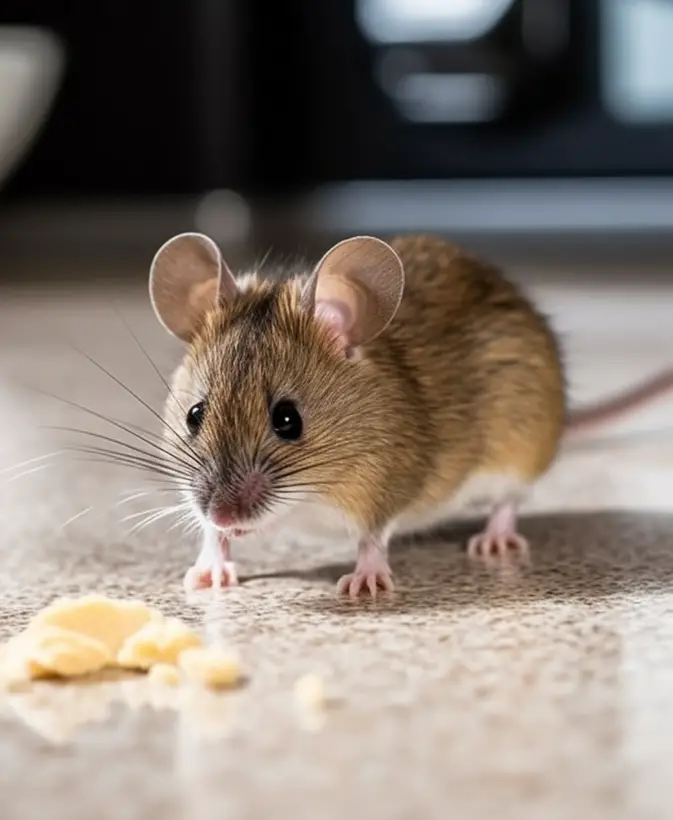How to Get Rid of Mice with Vinegar: The DIY Solution for a Mouse-Free Home!
The solution to your mouse problem might be hiding in your pantry. It may sound surprising, but that humble vinegar bottle can be your secret weapon in getting rid of those pesky rodents.
So, what’s the process of how to get rid of mice with vinegar? First, you’ll need to identify the problem areas where mice tend to frequent, such as entry points, nesting spots, and signs of their presence. Once you’ve pinpointed these areas, use vinegar spray, soaked vinegar cotton balls, or infuse traps with vinegar.
This article is your ultimate guide to getting rid of mice with vinegar. We’ll cover the steps to use this chemical, essential tips, and more.
How Vinegar Gets Rid of Mice

When it comes to using vinegar to get rid of mice, there are a few fundamental mechanisms at play:
- Strong odor: Vinegar has a strong and pungent odor that repels mice. Mice have highly sensitive olfactory senses, and the strong scent of vinegar is overwhelming and unpleasant. This makes them avoid areas where vinegar is present.
- Disruption of scent trails: Mice rely on scent trails to navigate and communicate with each other. Vinegar disrupts these trails, making it difficult for mice to find their way around or locate food sources.
- Confusion and discomfort: The pungent odor of vinegar can cause discomfort to mice. It irritates their nasal passages and can even affect their respiratory systems. This discomfort further discourages mice from staying in areas treated with vinegar.
- Taste sensitivity: Mice have taste receptors highly sensitive to bitter and robust flavors. With its acidic properties, vinegar has a strong, unpalatable taste to mice.
Why Should You Use Vinegar Over Other Methods?

Vinegar is often preferred over other methods of getting rid of mice due to several compelling reasons:
- Natural and non-toxic: Vinegar is a natural and non-toxic solution. Unlike chemical-based products that may pose health risks or leave harmful residues, vinegar provides a more environmentally friendly approach to pest control.
- Cost-effective: Vinegar is readily available at affordable prices. This affordability makes it an attractive option. This is true if you are on a budget or looking for a practical and economical way to address your mouse infestation.
- Accessibility: This substance is also easily accessible, making it a convenient solution for anyone with a mouse problem. Whether you have white vinegar, apple cider vinegar, or any other type, it’s likely already in your pantry. It can also be easily obtained from local grocery stores.
- Versatility: Vinegar offers versatility in its application methods. You can use vinegar in different forms to combat infestation. This versatility allows you to target specific areas or customize your approach based on the severity of the infestation.
- DIY approach: Using vinegar, you don’t have to rely on professional exterminators or complicated procedures. With vinegar, you can take matters into your own hands and actively participate in creating a mouse-free environment.
Step-by-Step Guide on How to Get Rid of Mice with Vinegar

Here is precisely how you can use this solution as a remedy to your mice infestation:
Step 1: Identify Problem Areas
- Begin by thoroughly inspecting your home for signs of mouse activity. Look for small, pellet-like droppings in cupboards, pantries, or along baseboards.
- Also, check for gnaw marks on wires, furniture, other objects, and chewed cardboard or paper materials.
Step 2: Prepare Vinegar Solutions
You have a few options to use vinegar as a mouse repellent effectively.
- One approach is to use undiluted white vinegar, as its strong odor has a more potent impact on mice.
- Alternatively, you can create a vinegar-water mixture by combining equal vinegar and water. This diluted solution is equally effective. It is preferable if you find the undiluted vinegar scent overpowering.
Step 3: Apply Vinegar Spray
Now, it’s time to put the vinegar solution to work. Spray the vinegar solution in areas where mice are active. These are the areas that you identified in step one.
Step 4: Place Soaked Cotton Balls or Rags
To further enhance the effectiveness of vinegar in repelling mice, position vinegar-soaked cotton balls or rags in areas frequented by mice.
Focus on locations near entry points, in corners, or behind furniture. Remember to replace the cotton balls or rags every 3 days to maintain the potent scent of vinegar.
Step 5: Create Vinegar-Infused Traps
In addition to using vinegar as a spray and in soaked cotton balls, you can also utilize vinegar to enhance the effectiveness of mouse traps. Mice are wary of scents and may avoid traps humans have handled. To mitigate this, you can use vinegar to mask your scent.
- First, prepare a solution by diluting vinegar with water in a 1:1 ratio.
- Dip a cloth or sponge in the vinegar solution and thoroughly wipe down the traps. This helps remove any lingering human scent.
- Then, rinse the traps with water and dry them thoroughly before setting them up.
By reducing your scent on the traps, you increase the chances of mice approaching and triggering them. But mice are naturally cautious creatures. So, it may take time for them to approach the traps, even with the reduced human scent.
Step 6: Clean Surfaces with Vinegar
Clean surfaces with a vinegar solution to eliminate scent trails left by mice and discourage their return. Use this solution to wipe down surfaces, countertops, and floors, paying extra attention to areas where food is stored or prepared.

Step 7: Seal Entry Points
Seal mouse entry points or openings using appropriate materials such as caulk, steel wool, or expanding foam.
Step 8: Monitor and Repeat
Even after implementing the above steps, continuously monitor your home for signs of mouse activity. Regularly check for new droppings, gnaw marks, or other indicators that mice may still present.
If you notice any signs of renewed mouse activity, reapply the vinegar solutions as needed and refresh the vinegar-soaked cotton balls or rags.
When to Consider Other Mice Extermination Methods Over Vinegar

While vinegar can be effective in deterring mice, there are instances where other mice extermination methods may be more suitable. Here are some situations where you might want to consider alternative methods:
- Severe infestations: We recommend consulting with a professional pest control service in such cases. They have the expertise and resources to handle more extensive infestations using appropriate methods and treatments.
- Persistent infestations: If you continue to experience recurring mouse activity, it’s a sign that the vinegar may not effectively deter them. Persistent infestations may require a more comprehensive approach.
- Allergic reactions or sensitivities: If you or any household members experience adverse reactions when using or being exposed to vinegar, do not use it.
- Structural damage or safety concerns: If mice have caused significant structural damage to your home, it’s crucial to address the problem promptly. This could be chewing through electrical wires or creating nests in critical areas.
- Time constraints or ineffectiveness: If vinegar alone isn’t yielding satisfactory results, it may be necessary to explore alternative methods. These will offer more immediate and reliable solutions.
FAQs
Here are answers to questions that will come in the process of how to get rid of mice with vinegar.
Q: Can I Use Any Type of Vinegar to Repel Mice?
Yes, various types of vinegar can be used to repel mice. The most commonly used kinds of vinegar include white and apple cider vinegar. Both types have a strong odor that mice find repulsive. The choice between these vinegars often depends on personal preference and availability.
Q: How Long Does the Vinegar Odor Last and Remain Effective Against Mice?
Initially, vinegar’s pungent odor can last about three days, deterring mice from the treated areas. To maintain its effectiveness, regularly reapply vinegar. Also, refresh the vinegar-soaked cotton balls or rags, especially in areas of high mouse activity.
Q: Can I Use Vinegar to Repel Mice Outdoors?
No. Its effectiveness outdoors may be limited. Outdoor areas generally have larger spaces and open environments. This makes it challenging for vinegar to create a concentrated deterrent effect.
Conclusion
Vinegar can be a valuable tool in your arsenal for removing mice. Its pungent odor is a deterrent, disrupting scent trails and creating an environment that mice find unpleasant.
By following the step-by-step guide on how to get rid of mice with vinegar, you can implement a natural and non-toxic approach to mouse control. However, you should know that vinegar may not be a standalone solution for severe or persistent infestations.




